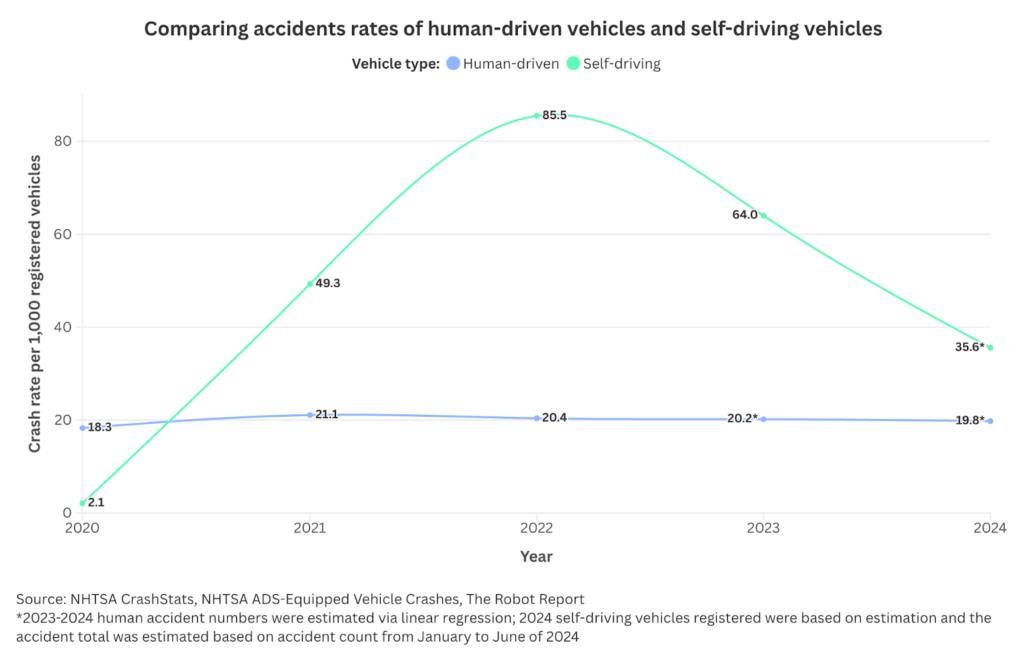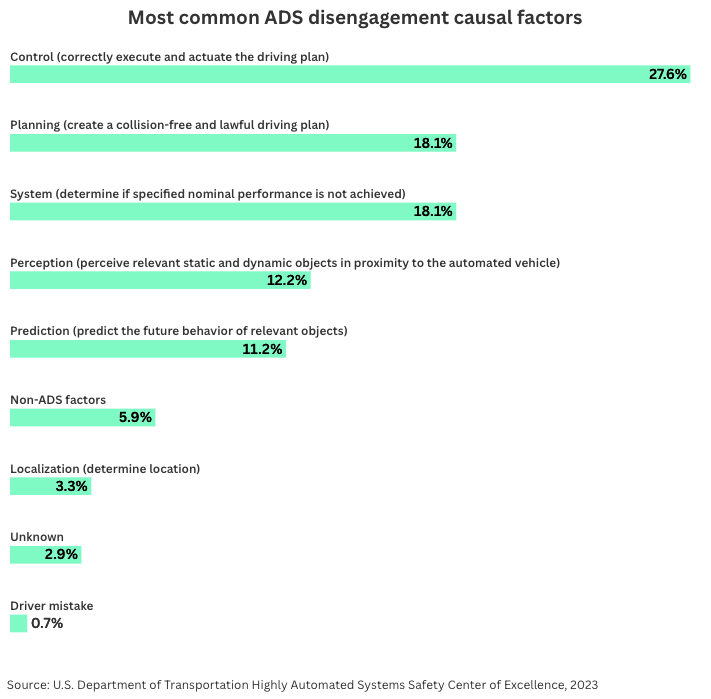Thank you for reading this post. This blog is published by our YouTube Channel, BRO. If you are looking for reliable, no B.S. ways to supplement your retirement income each month, check out the channel's course on Udemy. Remote Jobs for Retirees and Expats.
Waymo has introduced plans to check self-driving vehicles in 10 extra U.S. cities, together with San Diego and Las Vegas, in 2025. After years of gradual progress and technical roadblocks, this growth indicators that autonomous car (AV) know-how is lastly gaining floor.
However not everybody’s on board. A current AAA survey revealed that 6 in 10 U.S. drivers are scared to experience in a self-driving automobile. This concern is holding again adoption, whilst firms like Waymo, Tesla, and Cruise proceed testing and Increasing of Applications throughout the nation.
With this in thoughts, The Basic determined to look into the security of autonomous autos utilizing real-world knowledge from the Nationwide Freeway Visitors Security Administration (NHTSA), the U.S. Division of Transportation, and The Robotic Report. This text breaks down how the know-how works, crash charges, disengagement elements, and what issues nonetheless want fixing.
How Autonomous Car Expertise Works
Autonomous autos use a mixture of sensors, machine studying, and real-time decision-making to drive with out human enter, however not all techniques are created equal. The NHTSA makes an necessary distinction between Automated Driving Programs (ADS) and Superior Driver Help Programs (ADAS). ADS controls the automobile solely in particular circumstances, whereas ADAS helps human drivers with options like lane-keeping or automated braking.
Self-driving vehicles use radar, lidar, cameras, and onboard computer systems to watch their environment and reply shortly to what’s occurring on the highway. These instruments assist the car monitor visitors, highway circumstances, and obstacles. Synthetic intelligence takes in all that info and makes quick choices, just like how a human driver would react. Even with all that tech, firms like Waymo nonetheless depend on human drivers throughout testing as a part of their security practices. These drivers are educated to leap in if one thing goes incorrect.
Waymo’s autonomous autos have pushed over 56 million miles within the U.S. to date. Knowledge from these experiences helps refine the know-how, enhance security protocols, and construct belief with the general public and regulators.
Security Efficiency: What the Knowledge Reveals
In response to the NHTSA Standing Basic Order Crash Reporting DatabaseAVs have been concerned in over 3,900 crashes from 2019 by means of mid-2024. Of these, 496 resulted in accidents or fatalities. Right here’s how these numbers have grown since 2021:
- 2019: 4 crashes
- 2020: 25 crashes
- 2021: 641 crashes
- 2022: 1,450 crashes
- 2023: 1,353 crashes
- 2024 (Jan–June): 473 crashes
As self-driving vehicles log extra miles, the massive query isn’t what number of crashes they’re concerned in, however how usually. Uncooked numbers don’t inform the entire story, particularly as extra AVs hit the highway.
From 2021 and 2023, self-driving vehicles had a a lot larger crash fee per 1,000 autos than human-driven ones. The hole has narrowed, dropping from 85.5 per 1,000 in 2022 to an estimated 35.6 in 2024, however that’s nonetheless virtually double the human driver fee, which hovered close to 20 per 1,000 autos.
AV tech nonetheless has room to develop, nevertheless it’s bettering. In response to Waymo’s security affect reporttheir self-driving vehicles have considerably lowered the charges of crashes involving accidents, airbag deployments, and police studies in comparison with human drivers in Phoenix and San Francisco.
Disengagements: When People Take Over
Even essentially the most superior self-driving vehicles aren’t absolutely self-sufficient but. A key measure of progress in AVs is the disengagement fee, when the car both fingers management again to a human or the human security driver decides to take over. These moments are necessary for recognizing weak factors within the know-how.
A current U.S. Division of Transportation report breaks down the most typical causes AVs disengage. The commonest causes included:
- Management errors. The automobile didn’t execute the driving plan accurately, corresponding to turning, stopping, or steering.
- Planning failures. The system couldn’t determine a protected, authorized path to maintain driving.
- System points. The automobile didn’t carry out the best way it was speculated to throughout common driving circumstances.
- Notion gaps. The AV struggled to detect close by objects or visitors precisely.
- Prediction errors. The system couldn’t accurately forecast how different drivers or pedestrians would transfer.
Ongoing Points and Challenges
One of many largest challenges for self-driving vehicles is dealing with advanced, unpredictable conditions. Issues like human conduct, development zones, and dangerous climate can throw them off. Additionally they battle with subtler moments, like studying indicators from a visitors cop or reacting to drivers who break the principles. These actions might be tough to account for upfront, which makes it arduous to ensure security in each situation.
Right now’s AI isn’t prepared for every little thing the highway can throw at it. That’s why firms like Waymo are placing a lot time and vitality into making it smarter. Waymo is constructing AI Fashions that don’t simply comply with the principles. They’ll even be designed to see and react to the world round them extra like a human would. These fashions goal to mix driving expertise with broader reasoning expertise, so the system acknowledges patterns, predicts how others may behave, and makes smarter choices in actual time.
However there’s nonetheless the issue of AV knowledge assortment and reporting. Security and disengagement studies fluctuate from one producer, state, and testing program to the subsequent. A scarcity of standardization or clear benchmarks makes it tough to check efficiency outcomes and get a transparent image of what’s working, what’s not, and the way protected these autos truly are.
Transferring Ahead: Belief, Testing, and Transparency
Now not a futuristic idea, self-driving vehicles are right here, and so they’re bettering. AVs have logged hundreds of thousands of miles and discovered from hundreds of incidents. They’ve additionally began to slender the security hole with human drivers, however they’re not there but on the subject of absolutely changing folks behind the wheel.
Disengagements, notion errors, and planning failures are nonetheless widespread. To maneuver ahead, the trade wants clear security knowledge and standardized reporting. With out that, it’s arduous to know which techniques are really getting higher and which simply look good on paper.
Public belief additionally issues. Most drivers nonetheless really feel uneasy about self-driving vehicles. Constructing confidence will take extra real-world testing, smarter rules, and continuous tech enhancements, not simply guarantees from AV firms.
Autonomous driving isn’t good, nevertheless it’s evolving quick. If the trade can stability innovation with duty, the subsequent few years can be a turning level.
Methodology
This research leveraged the NHTSA CrashStats, NHTSA ADS-Outfitted Car Crashesand The Robotic Report to check the accident fee of human driving vs. automated autos. Moreover, it referenced the 2023 U.S. Division of Transportation Extremely Automated Programs Security Heart of Excellence report to know the most typical ADS disengagement causal elements.
This story was produced by The Basic and reviewed and distributed by Stacker.





